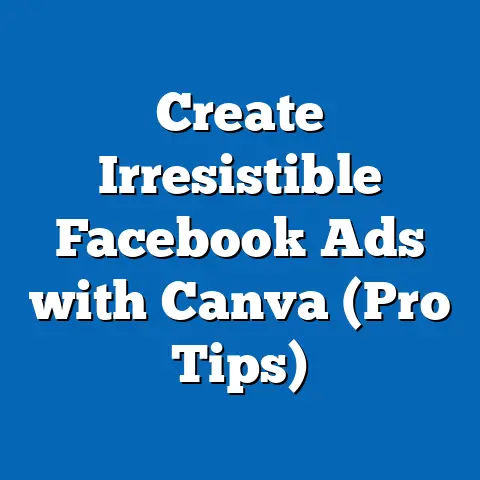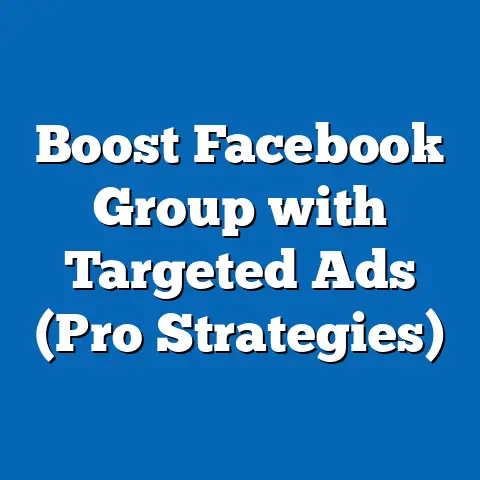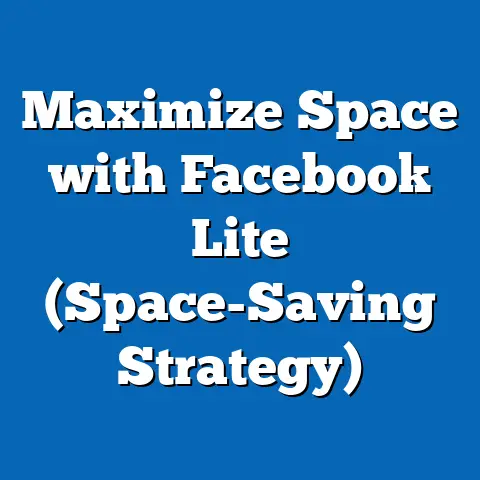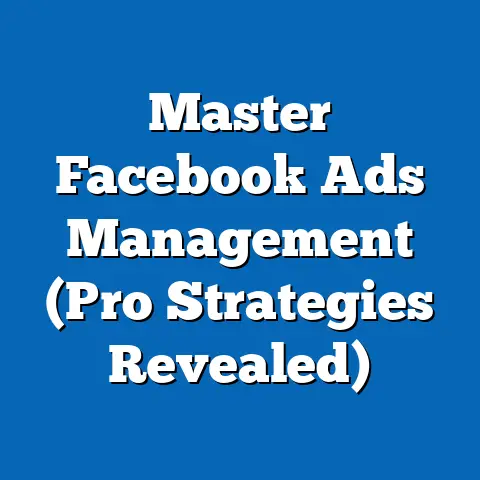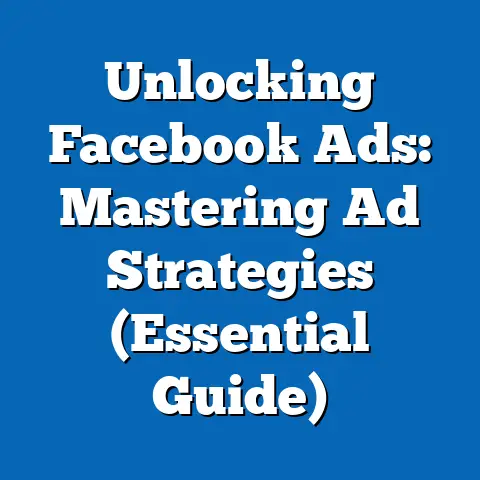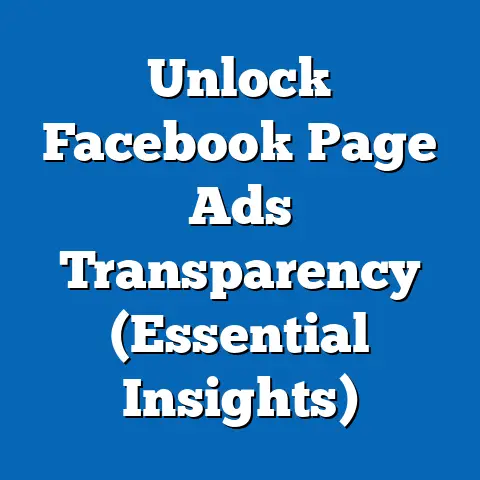Unlocking Block Ads on Facebook Android (Pro Tips Revealed)
Imagine you’re Odysseus, sailing the digital seas of Facebook on your Android device. You’re seeking connection, information, and maybe a little entertainment. But just like Odysseus faced sirens and sea monsters, we often encounter unwelcome obstacles: those pesky, irrelevant ads that seem determined to sink our ship. They pop up, clutter our feeds, and sometimes even make us want to abandon the voyage altogether.
Facebook ads, while a necessary part of the platform’s ecosystem, can sometimes feel like an intrusion. The good news is, you’re not powerless against them. Just as Odysseus used his cunning and knowledge to navigate treacherous waters, you can learn to manage and even “unlock” those blocked ads on your Facebook Android app, creating a smoother, more enjoyable experience. This article is your map, guiding you through the strategies to take control of your Facebook feed and tailor it to your interests. I’ll share my own experiences and insights, gleaned from years of navigating the ever-changing landscape of social media advertising, to help you become a master of your Facebook domain. Get ready to reclaim your feed and say goodbye to the irrelevant ad storm!
Understanding Facebook Ads
At its core, Facebook advertising is a powerful tool that connects businesses with potential customers. It allows companies to target specific demographics, interests, and behaviors, ensuring their message reaches the people most likely to be interested in their products or services. Think of it as a digital matchmaker, pairing brands with consumers who share common ground.
There are many different types of Facebook ads, each designed to achieve specific goals:
- Image Ads: Simple, visually appealing ads that showcase a product or service.
- Video Ads: Engaging ads that tell a story or demonstrate a product in action.
- Carousel Ads: Ads that feature multiple images or videos, allowing users to swipe through different offerings.
- Collection Ads: Ads that showcase a collection of products, often used for e-commerce.
- Lead Ads: Ads designed to capture leads by collecting user information directly within the Facebook platform.
When done right, Facebook ads can be beneficial for both advertisers and users. Advertisers can reach a highly targeted audience and drive sales, while users can discover new products and services that align with their interests. I’ve seen firsthand how a well-placed ad can introduce someone to their new favorite brand or solve a problem they didn’t even know they had.
However, the key to a positive ad experience is relevance. When ads are poorly targeted or overly intrusive, they can become a major source of frustration. This is where the concept of ad blocking comes into play. Users may choose to block certain ads or even ad categories to filter out content they find irrelevant or annoying.
Ad blocking on Facebook is more prevalent than you might think, especially on mobile devices. Studies have shown that a significant percentage of Facebook users actively avoid or block ads, driven by factors like irrelevant targeting, repetitive messaging, and concerns about privacy. In fact, a recent report by Statista estimated that mobile ad blocking rates are significantly higher compared to desktop, with rates varying by region. This trend highlights the need for advertisers to create more engaging and relevant ad experiences that respect user preferences.
Takeaway: Facebook ads are a powerful tool, but relevance is key. Understanding the different types of ads and the reasons why users block them is the first step towards unlocking a better Facebook experience.
Common Reasons for Blocked Ads on Facebook
Why do so many people choose to block ads on Facebook? It boils down to a few key factors:
- Irrelevant Targeting: This is perhaps the most common reason. When ads are targeted to the wrong audience, they feel intrusive and annoying. Imagine seeing ads for baby products when you have no children, or ads for luxury cars when you’re clearly not in the market. This disconnect can quickly lead to ad fatigue and a desire to block the offending content. I remember one time I kept seeing ads for a product I had already purchased! It was a clear sign that their targeting needed some serious refinement.
- Repetitive Ads: Seeing the same ad over and over again can be incredibly irritating. Even if the ad is initially relevant, the constant repetition can quickly turn it into a source of annoyance. This is especially true for ads that feature overly aggressive or pushy messaging. I’ve personally blocked ads simply because I couldn’t stand seeing them one more time.
- Intrusive Formats: Certain ad formats, such as pop-up ads or full-screen interstitials, can be particularly disruptive to the user experience. These formats often interrupt the flow of browsing and can feel aggressive and invasive. Users are more likely to block these types of ads in an effort to regain control of their screen.
- Privacy Concerns: Many users are concerned about the amount of data that Facebook collects and uses for ad targeting. They may feel uncomfortable with the level of personalization and the fact that their online activity is being tracked. This concern can lead them to block ads as a way to protect their privacy. I know I’ve adjusted my privacy settings multiple times to limit the data that Facebook collects about me.
The psychological impact of seeing unwanted ads can be significant. It can lead to feelings of frustration, annoyance, and even anger. This can negatively affect user engagement with the Facebook platform, causing people to spend less time on the site or even abandon it altogether.
Furthermore, users may inadvertently block ads due to privacy concerns or data tracking issues. For example, they might use ad blockers or privacy-enhancing browser extensions that block all ads by default. This can lead to a less personalized experience, as they may miss out on relevant ads that could actually be of interest to them.
Takeaway: Understanding the reasons why users block ads is crucial for both advertisers and Facebook itself. By addressing these concerns and creating more relevant, respectful ad experiences, it’s possible to reduce ad blocking and improve user satisfaction.
Pro Tips for Unlocking Block Ads on Facebook Android
Now that we understand why ads get blocked, let’s dive into some practical tips for unlocking those ads and tailoring your Facebook experience on Android. These strategies will help you gain control over the ads you see and ensure they’re more relevant and less intrusive.
Tip 1: Adjust Your Ad Preferences
This is the most fundamental step in managing your Facebook ad experience. Your ad preferences are like the control panel for your ad feed, allowing you to fine-tune the types of ads you see based on your interests and behaviors.
Here’s how to access and modify your ad preferences on the Facebook app:
- Open the Facebook app on your Android device.
- Tap the three horizontal lines (menu icon) in the top right corner.
- Scroll down and tap “Settings & Privacy,” then tap “Settings.”
- Scroll down to the “Ads” section and tap “Ad Preferences.”
Once you’re in the Ad Preferences section, you’ll find a variety of options for managing your ad settings:
- Your Interests: This section allows you to see the interests that Facebook has assigned to you based on your activity on the platform. You can remove interests that are no longer relevant or add new ones that reflect your current hobbies and passions. I regularly update my interests to ensure the ads I see are aligned with what I’m actually interested in.
- Advertisers You’ve Interacted With: This section shows you a list of advertisers whose ads you’ve interacted with in the past. You can choose to hide ads from specific advertisers if you find them annoying or irrelevant.
- Ad Settings: This section allows you to control how Facebook uses your data to personalize ads. You can limit the use of your information from partners, as well as your activity on Facebook, to personalize the ads you see.
By carefully managing your ad preferences, you can significantly improve the relevance of the ads you see on Facebook and reduce the likelihood of encountering irrelevant or annoying content.
Tip 2: Engage with Ads
This might sound counterintuitive, but interacting positively with certain types of ads can actually lead to a more relevant advertising experience. When you like, comment on, or share an ad, you’re signaling to Facebook that you’re interested in the product or service being advertised. This, in turn, can lead to you seeing more ads that are similar in nature.
I’ve personally experienced this phenomenon. For example, I once liked an ad for a new brand of coffee. As a result, I started seeing more ads for coffee-related products and services, which I actually found quite helpful. It introduced me to new brands and products that I might not have otherwise discovered.
Of course, it’s important to be selective about the ads you engage with. Don’t just like every ad you see. Focus on engaging with ads that genuinely interest you or that you think might be relevant to your needs. This will help Facebook to refine its understanding of your preferences and deliver more targeted advertising.
Tip 3: Clear Cache and Data
Over time, the Facebook app can accumulate a significant amount of cache and data. This data includes information about your browsing history, your interactions with ads, and your overall usage of the app. This data is used to personalize your ad experience, but it can also lead to you seeing irrelevant or repetitive ads.
Clearing the cache and data for the Facebook app can help to reset the ad algorithms and give you a fresh start. Here’s how to do it on your Android device:
- Go to your Android device’s Settings app.
- Tap “Apps” or “Application Manager.”
- Find and tap “Facebook” in the list of apps.
- Tap “Storage.”
- Tap “Clear Cache” and then “Clear Data.”
Keep in mind that clearing the data will log you out of the Facebook app, so you’ll need to re-enter your login credentials. It may also take a little while for the app to rebuild its cache and data, so you might notice a slight performance slowdown in the short term.
However, the long-term benefits of clearing the cache and data can be significant. It can help to improve the relevance of the ads you see, reduce the frequency of repetitive ads, and even improve the overall performance of the Facebook app.
Tip 4: Use Facebook’s Feedback Tools
Facebook provides a variety of tools that allow you to provide feedback on the ads you see. These tools can be used to report ads that are irrelevant, offensive, or misleading. By providing feedback, you can help Facebook to improve the quality of its advertising and reduce the likelihood of you seeing similar ads in the future.
To report an ad, simply tap the three dots in the top right corner of the ad and select “Report Ad.” You’ll then be asked to provide a reason for reporting the ad. Be as specific as possible in your feedback. The more information you provide, the better able Facebook will be to address the issue.
I’ve used the feedback tools on numerous occasions to report ads that I found to be offensive or misleading. In most cases, the ads were quickly removed, and I noticed a significant improvement in the quality of the ads I saw in the future.
Tip 5: Explore New Interests
Sometimes, the reason you’re seeing irrelevant ads is simply that your interests have changed. What you were interested in a year ago might not be what you’re interested in today. To refresh the ad algorithm and receive ads that align more closely with your current preferences, it’s important to explore new interests on Facebook.
This can involve liking new pages, joining new groups, or simply engaging with content that reflects your current hobbies and passions. The more you explore new interests on Facebook, the more likely you are to see ads that are relevant and engaging.
I often find myself exploring new interests on Facebook. For example, I recently became interested in learning how to play the guitar. As a result, I started liking pages and joining groups related to guitar playing. This led to me seeing ads for guitars, guitar lessons, and other guitar-related products, which I found to be incredibly helpful.
Tip 6: Participate in Groups and Pages
Joining and actively participating in groups and pages that reflect your personal interests can be a powerful way to tailor your ad experience. When you join a group or page, you’re signaling to Facebook that you’re interested in the topic being discussed. This can lead to you seeing more ads that are related to that topic.
For example, if you’re interested in cooking, you might join a group or page dedicated to sharing recipes and cooking tips. As a result, you might start seeing ads for kitchen appliances, cooking ingredients, and other cooking-related products.
I’ve found that participating in groups and pages is a great way to discover new products and services that align with my interests. It’s also a great way to connect with other people who share my passions.
Tip 7: Turn Off Ad Personalization
If you’re truly fed up with personalized ads, you can choose to turn off ad personalization altogether. This will prevent Facebook from using your data to personalize the ads you see.
To turn off ad personalization, go to the “Ad Settings” section of your Ad Preferences and toggle the “Ads based on data from partners” and “Ads based on your activity on Facebook” settings to the “Off” position.
Keep in mind that turning off ad personalization will not eliminate ads entirely. You’ll still see ads on Facebook, but they will be less relevant to your interests. You might also see more generic or irrelevant ads.
Takeaway: By implementing these pro tips, you can take control of your Facebook ad experience on Android and ensure that the ads you see are more relevant, engaging, and less intrusive.
Conclusion
Navigating the world of Facebook ads can feel like a constant battle, especially on your Android device. But by understanding the reasons why ads get blocked and implementing the pro tips outlined in this article, you can take control of your Facebook experience and create a feed that is both enjoyable and informative.
Remember, managing your ad preferences, engaging with relevant ads, clearing your cache and data, using Facebook’s feedback tools, exploring new interests, participating in groups and pages, and even turning off ad personalization are all powerful strategies for unlocking those blocked ads and tailoring your Facebook experience to your specific needs and preferences.
Ultimately, being proactive in managing your social media interactions empowers you to shape your online environment and ensure that it aligns with your values and interests. So, take action today, implement these tips, and reclaim your Facebook feed!
Call to Action
I’d love to hear about your experiences with Facebook ads on Android. Have you tried any of these tips? What other strategies have you found helpful? Share your thoughts and insights in the comments section below! Let’s build a community of savvy Facebook users who are empowered to take control of their online experience.

